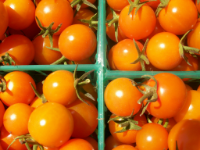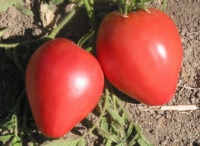A few weeks ago I had the opportunity to teach a class at our own Portland Nursery on Growing Cover Crops in the Home Garden. The turnout was impressive and it made me realize that there is more and more excitement and interest in this important organic gardening practice, so its time for a blog!!
When the first fall rains come here in Portland, and all the tomatoes turn to mush on the vine, it can often feel like the growing season is emphatically over. If you haven't planned ahead and planted a winter garden, the growing season is indeed drawing to a rapid close. But even if you won't be harvesting from your garden in the rainy season, there are a variety of things you can do to revitalize and take care of the garden that has taken such good care of you over the season.
Growing a living "Cover Crop" is one of the best ways to take care of and replenish your garden in the winter months. Cover Crops offer an overwhelming variety of benefits to your garden insulating, protecting, conditioning and revitalizing your precious soil! This blog post will give you the information you need to understand, choose, plant, and maintain your own home-grown cover crop! So lets dig right in...
Mature Cover Crop at the UC Santa Cruz Farm. Bell Beans, Oats, and Vetch
What are Cover Crops?
Cover Crops, sometimes also called "green manures," are crops/plants that are grown for a variety of reasons, other than for consumption, in larger quantities (to “cover” an area) and to maintain/improve the health of the soil and garden. They are most often planted during Winter, though not exclusively.
Farmers and gardeners have taken a hint from natural ecosystems in adopting cover cropping techniques. If you take a look at any natural environment you will see cover cropping happening naturally!! Whether in forests, grasslands, or even in deserts, growth and ground cover will happen wherever conditions will allow.
What are the advantages/benefits of growing cover crops?
So many!!! Some of the most important include:
Adding fertility to soil by capturing atmospheric nitrogen (nitrogen fixation by legumes)
Increasing soil organic matter and increasing soil biological activity (by growing biomass)
Preventing soil erosion and compaction from fall and winter precipitation (by providing ground covering)
Capturing and cycling nutrients (especially leachable nitrogen)
Improving soil structure and “tilth” by the action of roots and in the decomposition of plant material
Improving drainage in soil through root penetration and increase in soil organic matter
Suppression of weeds and conservation of moisture (by providing ground cover)
Increasing habitat for beneficial insects
Pest and disease suppression
The fibrous root systems of grasses are especially helpful in cover cropping suppressing weeds, improving drainage, and conditioning soils.
What are the different types of Cover crops?
Most cover crops fall into one of three categories representing different important and useful plant families.
Grasses/Grains
Plants in the grass family are extremely helpful in cover cropping for a variety of reasons. Their extensive fibrous root systems are excellent at conditioning soil, improving soil structure, and water infiltration. Their habitat of covering ground and crowding out other plants makes them excellent for weed suppression and prevention of erosion, while their vigrous vegetative growth help increase the level of organic matter in soils.
Common Grasses/Grains used in Cover Cropping include: Rye, Wheat, Oats, Barley, Triticale, and Sudan Grass
Legumes
The Legume family is the one plant family in the whole plant kingdom which has the ability to capture Nitrogen from the atmosphere and store it in the soil. Legumes accomplish this through a complex cooperation with specific strains of bacteria that live on their roots. For more info on Nitrogen Fixation check out this great article from ... "Nitrogen Fixation" is definitely the most important contribution of Legumes, however they are also helpful in increasing soil organic matter, suppressing weeds, and providing habitat for beneficial insects
Common Legumes used in Cover Cropping include: Clovers (Crimson, Red, and White) Vetches (Common, Hairy, and Purple) Beans (Fava, Bell, Soy) and Peas (Field, Austrian Winter)
Crimson Clover is an excellent cover crop for fixing nitrogen in the soil. It is grown widely in the Willamette Valley and the spring blooms are not to be missed!!
Brassica ("Cabbage" or "Mustard") Family
Certain members of the Brassica family play important roles in cover cropping. Plants like Daikon Radish with powerful taproots are used in breaking up compaction in soils. Other Brassicas are used in suppressing pests and diseases through the release of natural chemicals in their roots. Because they are so deeply rooted, Brassicas also play an important role in scavenging and cycling nutrients.
Common Brassicas used in Cover Cropping include: Daikon Radish, Mustard, and Rape (Canola)
Buckwheat
Buckwheat is in a category all its own but is used extensively as a summer cover crop and so deserves mention here. Buckwheat is a vigorous, heat loving plant which germinates and grows more quickly than most food crops and weeds. It is often used as a quick growing cover crop in between food crops. It is excellent for increasing soil organic matter and its precocious flowers provide incredible nectar and pollen sources for bees and other beneficial insects.
Which cover crop(s) should I use?
The first step in choosing your cover crop is to identify what your goal/goals are. In most cases a combination of cover crops are used together (often a grass and a legume) for their complementary effects.
Sowing a mixture of cover crops is an excellent way to enjoy a range of benefits for your garden. This mix from Johnny's Seeds contains: Clover, Rye, Peas, Oats, and Vetch
By matching your gardens specific needs to the benefits provided by different cover crops you will choose a combination that will best support your specific garden.
This "Cover Crop Solutions Chart" put out by Peaceful Valley Farm Supply is an excellent reference for choosing the perfect cover crop for your specific situation.
***If it is your first time ever growing a cover crop, I would suggest purchasing a cover crop mix from a local nursery. Naomi's Organic Farm Supply and Portland Nursery both sell mixtures that include four or five different cover crops each offering different benefits for your soil. Remember to take note of the suggested seeding rate/area so you know how densely to sow your mixture!***
When Should I Plant My Cover Crop?
The timing on the planting of your cover crop will depend on which cover crop/s you choose and what you plan to do with it in the spring. It will also depend on the weather which of course, is beyond our control.
Even given all of these variables, some general principles around planting can be followed...
A winter cover crop should be sown at such a time that it can become well established over the winter so as to do its jobs of covering soil, fixing nitrogen, suppressing weeds, etc... A cover crop that is planted too late in the fall does not become well established and fails to offer the many benefits which it is capable of.
On the other hand, a cover crop that is planted too early will become over mature and can become woody, and difficult to incorporate into the soil in the spring. Additionally, if cover crops are not removed or incorporated on time they can go to seed and cause weed problems in the following season.
***In general, Winter cover crops should be sown between September 15th and November 1st. If you are sowing a mix of seeds, October 1st-October 15th is a good planting window. ***
Image courtesy of Mother Earth News
How Should I Plant My Cover Crop?
Step 1: Remove all vegetable and weed and other plant material from the area to be cover cropped.
Step 2: Lightly till surface of soil with tilthing fork, hard rake, or garden claw. When very small seeds are to be sown (such as clover) create a fine seed bed with minimal clods. If larger seeds are to be sown (such as beans or peas) a coarse seedbed will suffice
Step 3: "Broadcast" or sprinkle seeds by hand following the recommended seeding rate.
Step 4: Incorporate the seeds you have sown using a chopping motion with a hard rake or hoe.
Step 5: Irrigate with an overhead sprinkler only if precipitation is not expected within a few days
Woohoo! Your done! Cover crops are extremely self sufficient. Winter rain will do the rest of the work, until you are called upon in the spring! Which leads us to...
Preparing a fine seedbed is especially important for small seeded cover crops like Clover
What should I do with my cover crop in the Spring?
So you have grown yourself a cover crop... You chose your seeds, prepared your soil, seeded the crop, and it has grown slowly but steadily throughout the winter. If your timing for seeding was right, your cover crop is close to waist high, it's late February, and you are thinking about vegetables again! So now what?
On most farms the answer would be, hop on the tractor and till it into the soil, chopping it into a million pieces where it would quickly begin to break down in your soil. As gardeners, working mostly with our hands, such a task is not quite as simple. When it comes to managing our cover crop we have a couple of choices.
Option 1: Incorporation
Using this method our task is, like the farmer on her tractor, to chop the mature cover crop into small pieces and turn it into the soil where it can decompose. Using hand tools like garden shears, pruners, or machete, and then turning the debris into the soil is no small task! In a larger garden, a weed whacker or powerful mower can aid in the process and a small rototiller can help with incorporation.
Even with the help of these tools, this method will always require a waiting period before your cover crop has broken down enough to allow planting. This waiting period can be from 1-2 months depending on how well your cover crop has broken down, and for a gardener in the Oregon Spring, this can seem like an eternity, especially if you don't have other garden space for early plantings.
Option 2: Composting Your Cover Crop
***This is my preferred method for managing a home grown cover crop. Especially in raised garden beds where garden space is generally at a premium.***
Using this method your cover crop is harvested, roots and all, and sent to a home compost pile. In your home compost, it can decompose slowly where all of the nutrients and fertility that have been captured can be stored and converted back into finished compost! This compost can be applied back to your garden the following Spring where it will offer all of the same advantages to your garden that it would have offered were it turned into the soil in the prior year.
The great advantage of this method is that you don't have to wait for cover crops to break down before planting into your garden in the Spring. The disadvantage is that you won't have all of the benefits of your cover crop in the year that it is planted. However, if you make cover cropping a part of your seasonal cycle, you will always have fertile finished compost to put back into your beds in the Spring!!
A mixed cover crop maturing: Rye, Hairy Vetch, Clover, and Field Peas are all visible here.














































